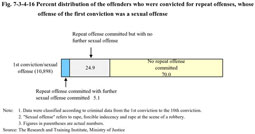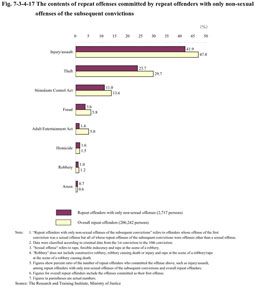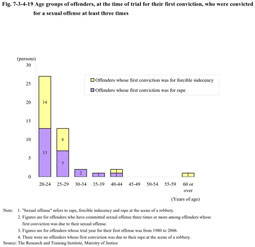| Previous Next Index Image Index Year Selection | |
|
|
5 Sexual offenses
In this subsection, sexual offenses (rape, forcible indecency and rape at the scene of a robbery; hereinafter the same in this sub-section), which have gained a lot of attention among people in recent years, are considered. Here too, the focus is made on persons whose offense of the first conviction was a sexual offense, since the point of view of how to prevent offenders receiving their first conviction from committing offenses again is important.
Fig. 7-3-4-16 shows the recidivism situation regarding those whose offense of the first conviction was a sexual offense (10,898 persons) among the 700,000 Non-Repeat and Repeat Offenders' Recorded Convictions. Fig. 7-3-4-16 Percent distribution of the offenders who were convicted for repeat offenses, whose offense of the first conviction was a sexual offense 30.0% of persons who had committed a sexual offense as their offense of the first conviction subsequently committed a repeat offense, but the percentage of those whose offenses of the subsequent convictions include a sexual offense was low at 5.1%. In other words, 24.9% of those whose offense of the first conviction was sexual offense were subsequently convicted for a repeat offense other than a sexual offense.Fig. 7-3-4-17 shows the contents of repeat offenses committed by those whose offense of the first conviction was a sexual offense but all of whose repeat offenses of the subsequent convictions were offenses other than a sexual offense (hereinafter referred to as “repeat offenders with only non-sexual offenses of the subsequent convictions” in this subsection.). Fig. 7-3-4-17 The contents of repeat offenses committed by repeat offenders with only non-sexual offenses of the subsequent convictions This figure shows percent ratios of those who committed the offenses listed on the vertical axis among repeat offenders with only non-sexual offenses of the subsequent convictions and overall repeat offenders, respectively.For repeat offenders with only non-sexual offenses of the subsequent convictions, the percent ratio was over 40% for injury/assault, over 20% for theft and about 10% for the Stimulants Control Act violations in that order, and this trend is almost the same as that of overall repeat offenders. On the other hand, in regard to persons whose offense of the first conviction was a sexual offense and whose offenses of the subsequent convictions included sexual offenses, Fig. 7-3-4-18 shows the number of offenders by number of convictions for sexual offenses, divided into those all of whose convicted repeat offenses were sexual offenses and those whose convicted repeat offenses were not (i.e. those whose convicted repeat offenses also included offenses other than sexual offenses). Fig. 7-3-4-18 Number of offenders by number of convictions for sexual offenses Those convicted for a sexual offense three times or more totaled 107 persons (0.015% of the 712,898 subjects of analysis, and 0.98% of the 10,898 persons whose offense of the first conviction was a sexual offense).These persons can be considered having a particularly strong tendency to commit sexual offenses. Among those convicted for a sexual offense many times, there were a considerable number of those who were repeatedly convicted for sexual offenses only, but on the other hand, there were also many who were convicted for offenses other than sexual offenses between sexual offenses (however, it should be noted that offenses other than sexual offenses can include offenses that possibly include contents related to sexual offenses, such as public indecency, breaking into a residence, kidnapping and buying or selling of human beings, and Minor Offenses Act violations.).The offense (convictions) most frequently committed by those who were repeatedly convicted for a sexual offense three times or more was theft (36.2%). Next, in regard to those who were convicted for a sexual offense three times or more, Fig. 7-3-4-19 shows the age groups at the time of trial for their first conviction. Fig. 7-3-4-19 Age groups of offenders, at the time of trial for their first conviction, who were convicted for a sexual offense at least three times Most persons were convicted for a sexual offense for the first time in their twenties, thus revealing that those with a strong tendency for a sexual offense committed a sexual offense to conviction when they were young.Summarizing the above, in regard to persons whose offense of the first conviction was a sexual offense, the percentage of those who were later convicted for a repeat offense (30.0%) was more than that with the overall convicted offenders (28.9%). However, the percentage of those who were convicted for the same kind of offense was quite low at 5.1% in the case of sexual offenses, as mentioned above, while it is 28.9% in the case of theft, 29.1% in the case of Stimulants Control Act violations, 21.1% in the case of injury/assault, and 11.0% in the case of fraud (see Subsection1 of this Section). Also, the trend with the type of offense of the subsequent convictions was almost the same as that with overall repeat offenders, revealing that many of those convicted for sexual offenses did not have any peculiar characteristics different from that of other offenders. However, on the other hand, it was indeed proved that there exist some persons who get repeatedly convicted for sexual offenses many times, who are considered to have particularly strong tendencies in their characters to repeat sexual offenses. Also, in regard to these persons, many of them were convicted for a sexual offense as their first-time offense in their youths. |



